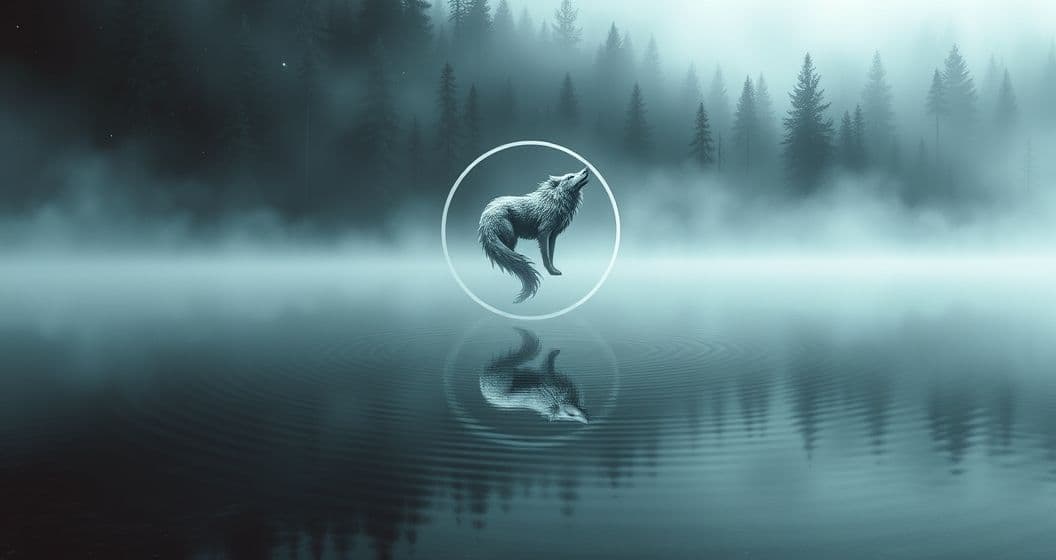Core Symbols: The Wolf Sigil and Its Mirror
A wolf sigil in dreams is rarely random—it functions as a personalized message from the subconscious, often marked by bold, primal imagery. Unlike generic wolf symbols, sigils carry emotional specificity: a snarling sigil might signal suppressed anger, while a howling one could represent longing for freedom. When paired with a wolf mirror, the sigil’s message becomes a reflection loop: the sigil is the call, the mirror is the response. Imagine a dream where a glowing wolf sigil appears on a cracked mirror; the crack might symbolize a fractured self-perception, while the wolf’s gaze demands you reconcile those cracks with your true nature.
The wolf mirror itself is a paradoxical symbol. In dreams, mirrors typically reflect self-awareness, but a wolf mirror merges that introspection with the animal’s primal intelligence. This isn’t just a reflection of your face—it’s a mirror of your instinctual self, the part that thrives on intuition rather than overthinking. If the wolf in the mirror is calm, you may be aligning with your authentic voice; if it’s pacing, you might be ignoring urgent inner signals.
Psychology Lens: Jungian Shadows and REM Processing
Want a More Personalized Interpretation?
Get your own AI-powered dream analysis tailored specifically to your dream
🔮Try Dream Analysis FreeFrom a Jungian perspective, the wolf embodies the shadow archetype—the parts of ourselves we’ve disowned or feared. The sigil acts as the shadow’s “signature,” marking areas where you’ve buried courage, creativity, or primal needs. The mirror then becomes the conscious mind’s confrontation with these buried aspects, forcing integration rather than suppression. For example, someone avoiding a career change might dream of a wolf sigil on a mirror, where the wolf’s gaze urges them to acknowledge their desire for adventure.
Neuroscience adds another layer: during REM sleep, the brain processes emotional memories and unresolved conflicts. A wolf-mirror dream could be your brain’s way of “replaying” emotional data, using the wolf as a metaphor for the intensity of those feelings. The mirror amplifies this by making the emotion tangible—you’re not just feeling anxiety; you’re seeing it reflected back as a wolf’s gaze. This isn’t random imagery; it’s your brain’s attempt to help you make sense of fragmented emotions.
Life Triggers: When the Subconscious Calls
Wolf sigils and mirrors often surface during pivotal life moments. Career transitions, for instance, push you to confront whether you’re living authentically—a wolf sigil on a mirror might appear if you’re torn between a “safe” path and a “wild” dream. Similarly, relationship endings can trigger these dreams, as the mirror reflects your unmet needs (the wolf’s howl becomes a cry for connection).
Cultural context also matters: if you’ve recently studied Norse mythology or spent time in nature, the wolf’s wisdom archetype (Odin’s companions, Fenrir) might surface. A city dweller might dream of a wolf sigil on a mirror to reconnect with their primal roots, while someone in a creative field could see it as a call to embrace bold self-expression.
What To Do Next: From Dream to Daily Life
Start with short-term reflection: Grab a notebook and sketch the dream’s details—how did the wolf sigil look? Was the mirror clear or foggy? What emotions did you feel? Journaling helps you map the subconscious’s language. Notice if the wolf’s posture matched your real-life stance: a slouched wolf might mean you’re “hiding” parts of yourself.
For medium-term exploration, create a physical sigil. Use charcoal to draw a wolf shape, adding personal symbols (a star for hope, a line for connection) to represent the message. Place it near your mirror as a daily reminder to check in with your intuition. When you feel “called” to act (like the sigil’s urgency), pause and ask: Is this aligned with my true self?
Long-term integration means honoring the wolf’s wisdom in small ways. If the dream urged you to be bold, try one new thing weekly that scares you gently. The mirror will show if these steps bring clarity or confusion—both are progress. Remember: the wolf-mirror dream isn’t a judgment; it’s a conversation.
FAQ: Navigating Wolf-Mirror Dreams
Q: What if the wolf in my dream feels threatening?
A: A threatening wolf signals fear of your untamed qualities. The mirror suggests examining which parts feel “too wild” to face, then integrating them gently rather than suppressing. Ask: What do I fear losing if I embrace this aspect?
Q: Does the mirror’s condition affect the meaning?
A: A clear mirror shows self-clarity; a foggy one suggests confusion. If the mirror reflects a distorted wolf, you may be projecting fears onto yourself. If it’s familiar, you’re recognizing your true self.
Q: Are there cultural differences in wolf symbolism?
A: In Indigenous traditions, wolves teach community; in Norse myths, they’re Odin’s guides. Your dream blends personal context with universal archetypes—trust your unique feelings over rigid cultural definitions.
The wolf sigil and mirror dream is a bridge between your conscious and unconscious selves. It’s not a prediction but an invitation: to listen to the wild wisdom within, reflect on what needs acknowledgment, and integrate those truths into your waking life. The next time you see this imagery, remember: the mirror isn’t judging—it’s showing you the path to wholeness, one howl at a time.
